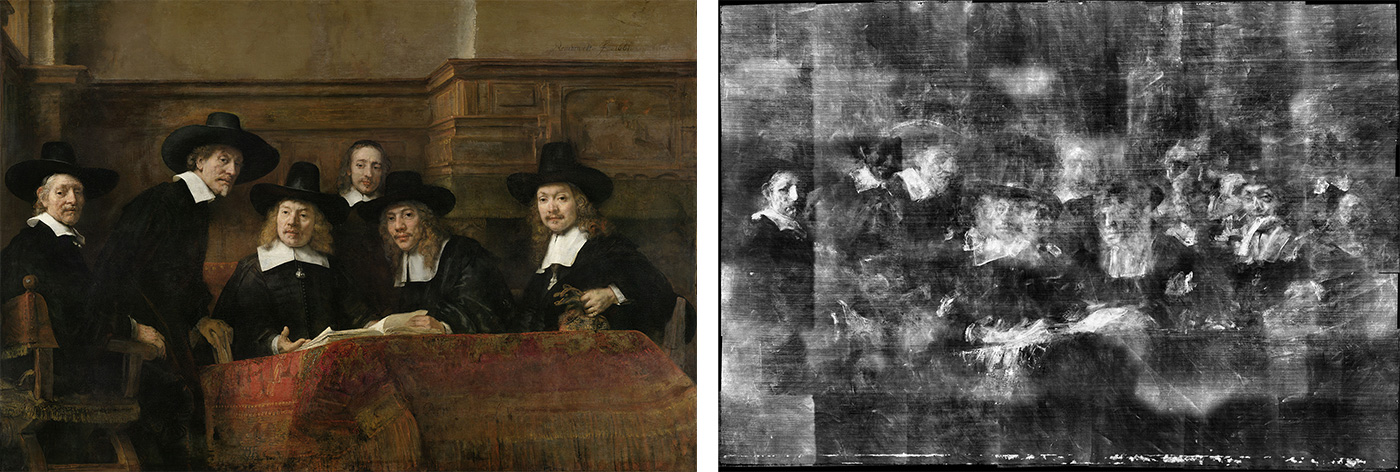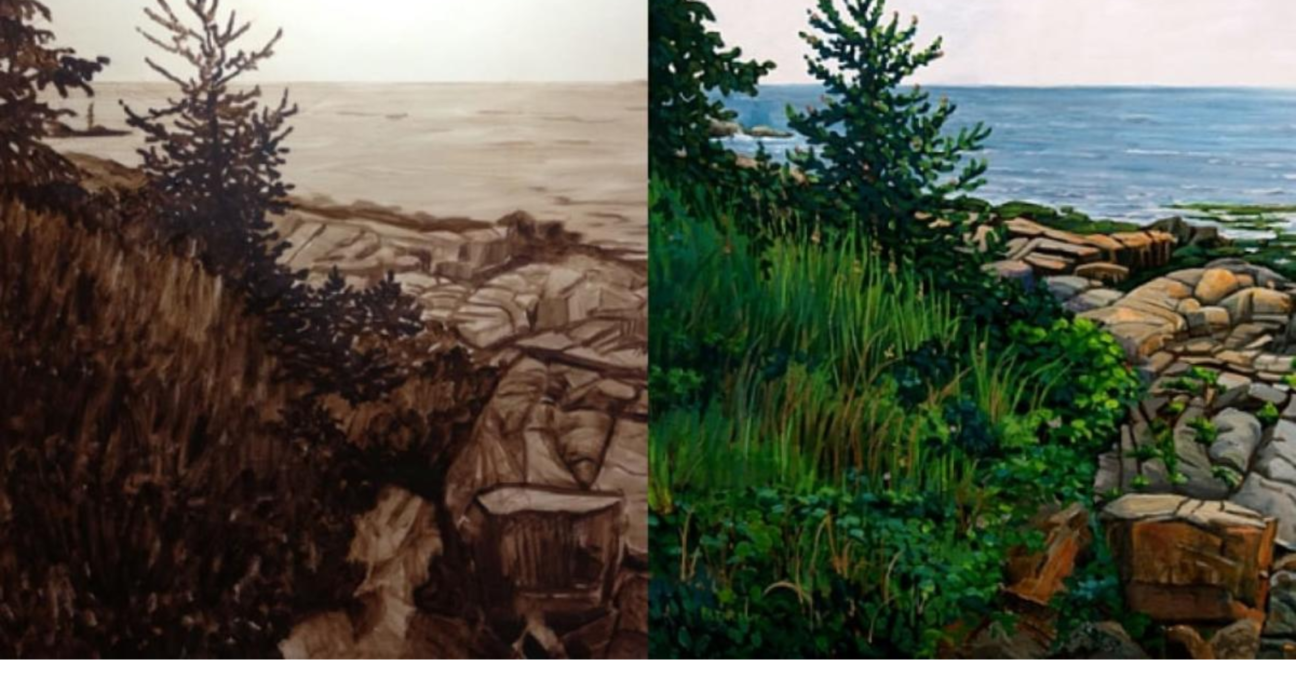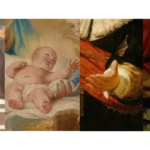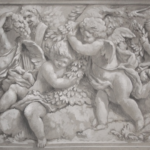Underpainting is a foundational technique in painting that serves as the invisible backbone of many artistic masterpieces. This method involves applying an initial layer of paint to the canvas or other surfaces before adding subsequent layers, creating depth, texture, and richness in the final artwork. Underpainting not only enhances the structural integrity of a painting but also provides artists with a unique opportunity to explore color relationships and tonal values.
The Art and Science of Underpainting
Underpainting is more than just a preparatory step in the painting process; it’s a sophisticated technique that combines artistic intuition with scientific principles. This foundational layer sets the stage for the entire composition, influencing everything from color dynamics to the overall mood of the piece.
Historical Roots of Underpainting

The practice of underpainting has deep historical roots, tracing back to the Renaissance period. Masters like Leonardo da Vinci and Rembrandt van Rijn utilized this technique to achieve the luminous quality in their paintings that continue to captivate viewers centuries later.
During the Renaissance, artists typically used earth tones or grisaille (shades of gray) for their underpaintings. This approach allowed them to establish the values and forms of their subjects before adding color. The result was a depth and richness that would have been difficult to achieve through direct painting alone.
The evolution of underpainting techniques paralleled advancements in paint production and artistic theory. As new pigments became available and artistic movements emerged, the approach to underpainting diversified, reflecting the changing aesthetics and technical possibilities of each era.
The Chemistry Behind the Canvas
Understanding the chemical interactions between paint layers is crucial for creating lasting artworks. Underpainting plays a significant role in this process, acting as a buffer between the canvas and subsequent layers of paint.
Different pigments and binders used in underpainting can affect the drying time, adhesion, and longevity of the final painting. For instance, oil-based underpaintings provide a smooth, flexible foundation that allows for better bonding with subsequent oil layers. On the other hand, acrylic underpaintings dry quickly and create a stable base for both acrylic and oil overpainting.
The choice of underpainting materials can also influence the optical effects of the final work. Transparent underpaintings allow light to penetrate and reflect off the canvas, creating a luminous quality, while opaque underpaintings provide a solid base that can dramatically alter the appearance of overlying colors.
Psychological Impact on Viewers
The subtle influence of underpainting extends beyond the technical aspects of painting to affect the viewer’s perception and emotional response to the artwork.
Underpainting can create a sense of depth and atmosphere that might not be immediately apparent but contributes to the overall impact of the piece. For example, a warm underpainting beneath cool surface colors can create a tension that draws the viewer in, even if they can’t pinpoint why.
Moreover, the layering process involved in underpainting can add a sense of history and complexity to a painting. This depth can engage viewers on a subconscious level, encouraging them to spend more time with the artwork and discover nuances that might not be apparent at first glance.
The Role of Underpainting in Artistic Expression
Underpainting is not merely a technical process but a crucial element in an artist’s expressive toolkit. It provides a means for artists to infuse their work with deeper meaning and personal style, often in ways that are subtle yet profound.
Conveying Emotion Through Layered Hues
The strategic use of color in underpainting can significantly influence the emotional tone of a painting. Artists can leverage this to create complex emotional landscapes within their work.
For example, a melancholic scene might be underpainted with cool blues and purples, even if the final layer presents warmer tones. This underlying coolness can seep through, creating a sense of underlying sadness or nostalgia that might not be immediately apparent but is felt by the viewer.
Conversely, a seemingly somber painting might have a vibrant, warm underpainting that peeks through in places, suggesting hope or hidden joy. This interplay between visible and hidden colors can create a rich emotional tapestry that engages viewers on multiple levels.
Narrative Layers: Telling Stories Through Underpainting
Some artists use underpainting as a means of embedding hidden narratives or symbolism within their work. By incorporating meaningful elements or even entire scenes in the underpainting, artists can create works with multiple layers of meaning.
These hidden elements might be partially visible, creating intrigue and encouraging closer inspection. In some cases, they might be completely obscured by subsequent layers, known only to the artist but contributing to the overall depth and mystery of the piece.
This approach to underpainting can transform a painting into a palimpsest of sorts, where traces of earlier ideas or iterations remain present beneath the surface, enriching the final composition with layers of history and meaning.
Personal Style and Artistic Signature
An artist’s approach to underpainting can become a distinctive part of their personal style. Some artists have become known for their unique underpainting techniques, which contribute significantly to the recognizable quality of their work.
For instance, an artist might consistently use bold, contrasting colors in their underpaintings to create a signature vibrancy in their finished pieces. Others might develop a particular texture or pattern in their underpainting that becomes a hallmark of their style.
The way an artist chooses to reveal or conceal their underpainting can also become part of their artistic signature. Some may leave areas of underpainting deliberately exposed, creating a window into their creative process, while others might use it more subtly to influence the overall tone and atmosphere of their work.
Mastering the Craft of Underpainting
Developing proficiency in underpainting requires a combination of technical skill, artistic intuition, and experimentation. This section explores the path to mastering this fundamental technique and its potential to transform an artist’s practice.
Essential Tools and Materials for Underpainting
The choice of tools and materials for underpainting can significantly impact the final result. Understanding the properties and potential of different mediums is crucial for effective underpainting.
Brushes for underpainting often differ from those used for final layers. Many artists prefer broader, flatter brushes for laying down initial color washes, while others might use palette knives or even unconventional tools like sponges or rags to create interesting textures.
The selection of paint for underpainting is equally important. Fast-drying mediums like acrylic or alkyd oils are popular choices, allowing artists to work quickly and build up layers efficiently. However, traditional oil paints can also be used for underpainting, especially when a longer working time is desired.
Surfaces play a crucial role in underpainting as well. While canvas is a common choice, many artists experiment with different grounds such as wood panels, linen, or even metal sheets, each offering unique properties that can enhance the underpainting process.
Developing an Eye for Underpainting
Mastering underpainting requires developing a keen eye for color relationships and tonal values. Artists must learn to see beyond the surface and understand how underlying layers will interact with subsequent applications of paint.
This skill often involves studying the works of master painters, analyzing how they used underpainting to achieve certain effects. Many artists find it helpful to create studies or small-scale experiments to explore different underpainting techniques before applying them to larger works.
Developing this visual acuity also means learning to anticipate how colors will shift and blend as layers are added. It’s a skill that combines technical knowledge with artistic intuition, often refined through years of practice and experimentation.
Balancing Planning and Spontaneity
One of the challenges in mastering underpainting is finding the right balance between careful planning and spontaneous creativity. While underpainting provides a structured foundation for a painting, it should not stifle the artist’s ability to respond intuitively to the evolving work.
Many experienced artists develop a flexible approach to underpainting, allowing room for unexpected discoveries and changes in direction. They might start with a loose underpainting that establishes basic values and composition, then refine and adjust as they build up subsequent layers.
This balance often involves knowing when to let the underpainting guide the process and when to deviate from the initial plan. It’s a dynamic interplay between structure and improvisation that can lead to exciting and innovative results.
Techniques and Applications in Contemporary Art

In the realm of contemporary art, underpainting continues to evolve, with artists pushing the boundaries of traditional techniques and exploring new possibilities. This section delves into the various approaches and innovative applications of underpainting in modern artistic practice.
Experimental Approaches to Underpainting
Today’s artists are not bound by historical conventions when it comes to underpainting. Many are experimenting with unconventional materials and methods to create unique effects and textures.
Some artists use textured mediums or collage elements in their underpaintings to create three-dimensional surfaces that interact with subsequent layers in unexpected ways. Others incorporate non-traditional materials like sand, coffee grounds, or even digital elements printed onto the canvas before applying paint.
The rise of mixed media art has also influenced underpainting techniques. Artists might combine acrylic underpainting with oil overpainting, or use watercolor resist techniques to create intriguing textures and color interactions.
Digital Underpainting in the Age of Technology
The digital revolution has not left underpainting untouched. Many contemporary artists use digital tools to plan and experiment with underpainting techniques before applying them to physical canvases.
Digital underpainting allows for rapid iteration and experimentation with color schemes and compositions. Artists can easily adjust values, test different color combinations, and visualize the final result before committing to paint on canvas.
Some artists have taken this a step further, creating entire underpaintings digitally and then printing them onto canvas or other surfaces before adding physical paint layers. This hybrid approach merges traditional painting techniques with digital precision and flexibility.
Underpainting in Non-Traditional Art Forms
The concept of underpainting has expanded beyond traditional painting to influence other art forms. In sculpture, for instance, artists might apply a base layer of material or color before adding final textures and finishes, mimicking the layering process of underpainting.
In digital art and animation, the principles of underpainting are often applied to create depth and atmosphere in 2D and 3D environments. Artists use base layers of color and texture to establish mood and lighting before adding details and characters.
Even in fields like fashion design and interior decoration, the concept of layering colors and textures to create depth and interest draws inspiration from the principles of underpainting.
Conclusion

Underpainting remains a cornerstone of painting technique, bridging the gap between an artist’s vision and its realization on canvas. From its historical roots to its contemporary applications, underpainting continues to evolve, offering endless possibilities for artistic expression and technical innovation. As artists continue to explore and push the boundaries of this foundational technique, underpainting will undoubtedly remain a vital element in the creation of compelling and enduring works of art.
✉️ Stay Connected — Subscribe for Weekly Updates
Discover timeless stories, practical wisdom, and beautiful culture — delivered straight to your inbox.
*We only share valuable insights — no spam, ever.






